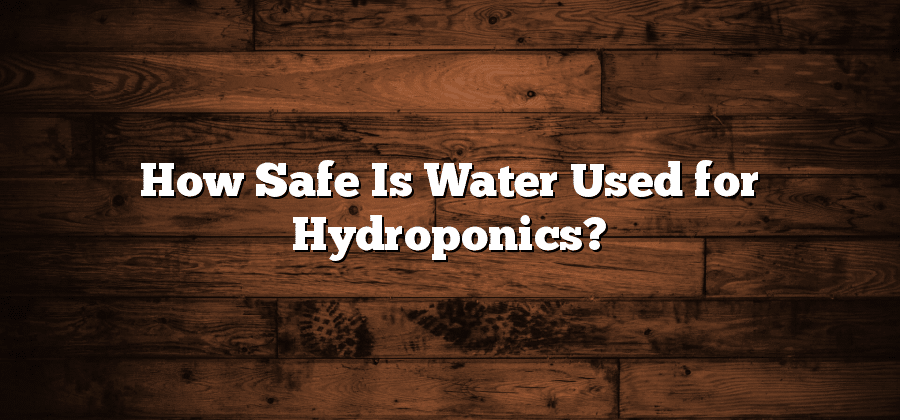Understanding Water Quality Standards for Hydroponics
Hydroponics is a method of growing plants without soil, using a nutrient-rich solution instead. The key to successful hydroponic cultivation lies in understanding the importance of water quality. Water serves as the primary medium through which nutrients are delivered to the plants, making it essential to ensure that the water used in hydroponic systems meets the appropriate quality standards.
One of the crucial parameters to consider when evaluating water quality for hydroponics is its pH level. pH refers to the acidity or alkalinity of a solution and can significantly influence nutrient availability to plants. In hydroponics, the optimal pH range for most plants is between 5.5 and 6.5. Deviations from this range can result in nutrient imbalances and hinder the growth and development of crops. Therefore, it is necessary to regularly monitor and adjust the pH of the water used in hydroponic systems to maintain optimal conditions for plant health and productivity.
Potential Contaminants in Hydroponic Systems and Their Impact
Hydroponic systems offer a controlled environment for plant growth, but they are not immune to potential contaminants that can have a significant impact on plant health and overall system performance. These contaminants can come from various sources, including the water used in the system, the nutrient solutions, as well as the equipment and materials employed in the setup.
Water, being a crucial element in hydroponics, can sometimes carry contaminants that need to be carefully considered. Chemical residues, such as pesticides or heavy metals, can find their way into the water supply and ultimately affect the plants. Additionally, organic matter, like algae or bacteria, can thrive in hydroponic systems, leading to nutrient imbalances and potential disease outbreaks. Recognizing these potential contaminants and their impact is essential for maintaining a healthy and thriving hydroponic system.
Evaluating Water Sources for Hydroponics: Municipal vs. Well Water
In hydroponic systems, choosing the right water source is crucial for the overall health and productivity of your plants. When it comes to evaluating water sources for hydroponics, two common options are municipal water and well water. Both have their advantages and disadvantages that need to be carefully considered.
Municipal water, which is supplied by the local government, is generally treated to meet certain quality standards. It undergoes processes such as filtration and disinfection to remove contaminants and ensure it is safe for human consumption. This can be beneficial for hydroponic growers as it reduces the risk of introducing harmful pathogens or chemicals to the plants. However, it is important to note that municipal water may still contain traces of chlorine or other disinfectants, which can negatively affect the nutrient solution and pH balance in the system.
On the other hand, well water is sourced directly from underground aquifers and does not go through the same treatment processes as municipal water. While this may be seen as a disadvantage, it can also be an advantage for hydroponics in some cases. Well water often contains natural minerals and nutrients that can benefit plant growth. However, it is important to have the well water tested regularly as it may also contain high levels of minerals, such as calcium or iron, which can lead to nutrient imbalances in the system. Additionally, well water may be more prone to contamination from agricultural runoff or other pollutants.
The Role of pH in Hydroponics and Maintaining Optimal Levels
Maintaining the optimal pH level is crucial in hydroponics to ensure the successful growth and development of plants. pH is a measure of how acidic or alkaline the nutrient solution is, on a scale of 0 to 14, with 7 being neutral. Most hydroponic crops thrive in a slightly acidic to neutral range, typically between pH 5.5 and 6.5.
The pH level of the nutrient solution affects the availability and uptake of essential nutrients by the plants. When the pH is too high or too low, certain nutrients can become less available or even become toxic to the plants. Additionally, pH levels that are too extreme can affect the functioning of beneficial microorganisms in the root zone. Therefore, it is crucial to regularly monitor and adjust the pH level in hydroponic systems to maintain optimal growing conditions.
Balancing Nutrient Concentrations in Hydroponic Solutions for Plant Health
Achieving the ideal balance of nutrients in hydroponic solutions is crucial for promoting healthy plant growth and maximizing crop yields. Each plant requires a specific combination and concentration of essential nutrients, such as nitrogen, phosphorus, potassium, and various micronutrients, for optimal development. Balancing nutrient concentrations in hydroponic solutions involves carefully monitoring and adjusting the nutrient levels to meet the specific requirements of each plant species.
One approach to balancing nutrient concentrations is through regular testing and analysis of the hydroponic solution. This involves measuring the electrical conductivity (EC) and pH levels of the solution, as well as periodically assessing the nutrient composition. By monitoring these parameters, growers can identify any imbalances or deficiencies in the nutrient solution and take appropriate corrective actions. This may include adjusting the nutrient ratios, increasing or decreasing the overall nutrient concentration, or adding specific nutrient supplements to address any deficiencies. It is essential to note that nutrient requirements may vary at different stages of plant growth, so regular testing and adjustment are essential throughout the entire grow cycle.






